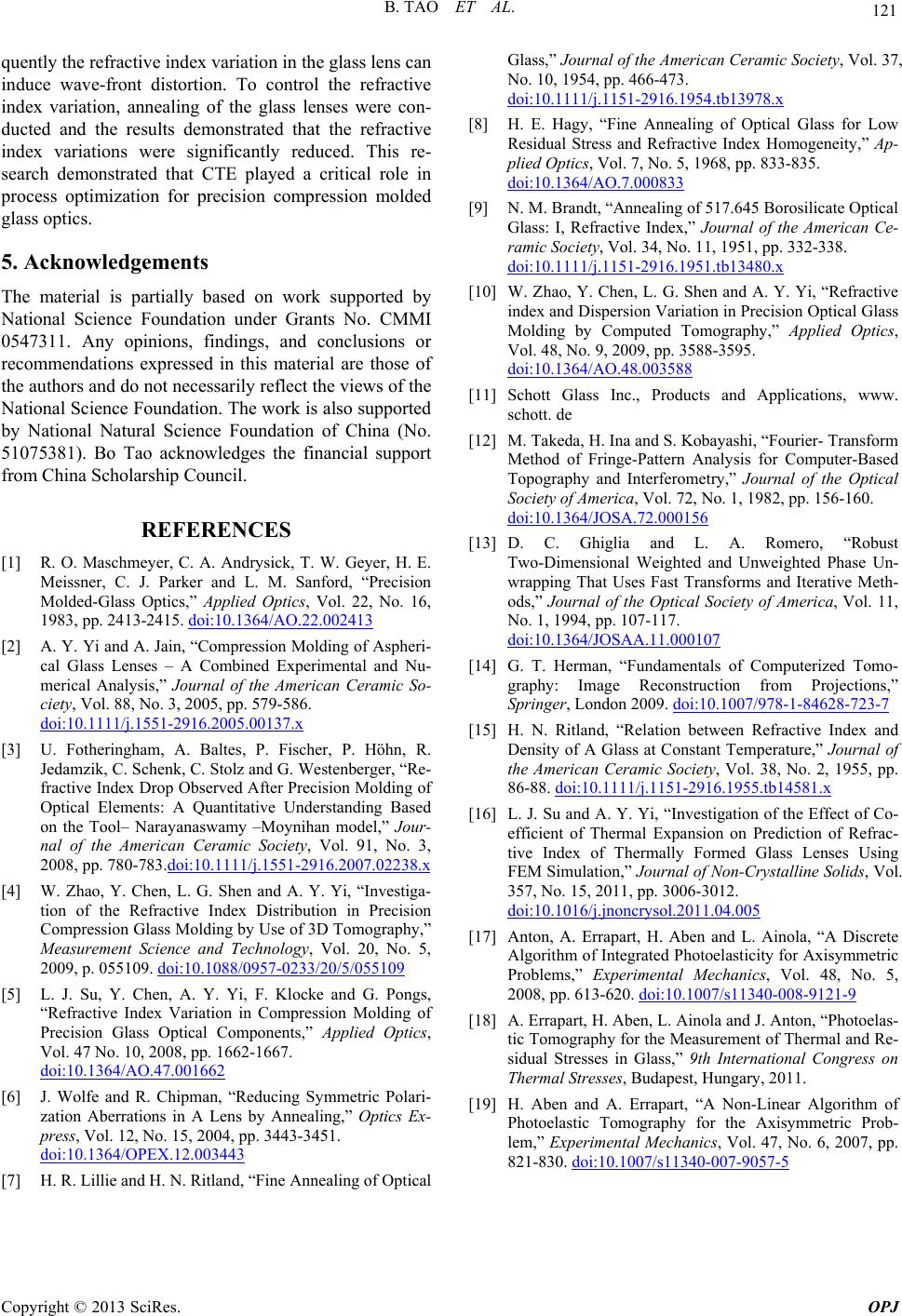
B. TAO ET AL.
Copyright © 2013 SciRes. OPJ
121
quently the refractive index variation in the glass lens can
induce wave-front distortion. To control the refractive
index variation, annealing of the glass lenses were con-
ducted and the results demonstrated that the refractive
index variations were significantly reduced. This re-
search demonstrated that CTE played a critical role in
process optimization for precision compression molded
glass optics.
5. Acknowledgements
The material is partially based on work supported by
National Science Foundation under Grants No. CMMI
0547311. Any opinions, findings, and conclusions or
recommendations expressed in this material are those of
the authors and do not necessarily reflect the views of the
National Science Foundation. The work is also supported
by National Natural Science Foundation of China (No.
51075381). Bo Tao acknowledges the financial support
from China Scholarship Council.
REFERENCES
[1] R. O. Maschmeyer, C. A. Andrysick, T. W. Geyer, H. E.
Meissner, C. J. Parker and L. M. Sanford, “Precision
Molded-Glass Optics,” Applied Optics, Vol. 22, No. 16,
1983, pp. 2413-2415. doi:10.1364/AO.22.002413
[2] A. Y. Yi and A. Jain, “Compression Molding of Aspheri-
cal Glass Lenses – A Combined Experimental and Nu-
merical Analysis,” Journal of the American Ceramic So-
ciety, Vol. 88, No. 3, 2005, pp. 579-586.
doi:10.1111/j.1551-2916.2005.00137.x
[3] U. Fotheringham, A. Baltes, P. Fischer, P. Höhn, R.
Jedamzik, C. Schenk, C. Stolz and G. Westenberger, “Re-
fractive Index Drop Observed After Precision Molding of
Optical Elements: A Quantitative Understanding Based
on the Tool– Narayanaswamy –Moynihan model,” Jour-
nal of the American Ceramic Society, Vol. 91, No. 3,
2008, pp. 780-783.doi:10.1111/j.1551-2916.2007.02238.x
[4] W. Zhao, Y. Chen, L. G. Shen and A. Y. Yi, “Investiga-
tion of the Refractive Index Distribution in Precision
Compression Glass Molding by Use of 3D Tomography,”
Measurement Science and Technology, Vol. 20, No. 5,
2009, p. 055109. doi:10.1088/0957-0233/20/5/055109
[5] L. J. Su, Y. Chen, A. Y. Yi, F. Klocke and G. Pongs,
“Refractive Index Variation in Compression Molding of
Precision Glass Optical Components,” Applied Optics,
Vol. 47 No. 10, 2008, pp. 1662-1667.
doi:10.1364/AO.47.001662
[6] J. Wolfe and R. Chipman, “Reducing Symmetric Polari-
zation Aberrations in A Lens by Annealing,” Optics Ex-
press, Vol. 12, No. 15, 2004, pp. 3443-3451.
doi:10.1364/OPEX.12.003443
[7] H. R. Lillie and H. N. Ritland, “Fine Annealing of Optical
Glass,” Journal of the American Ceramic Society, Vol. 37,
No. 10, 1954, pp. 466-473.
doi:10.1111/j.1151-2916.1954.tb13978.x
[8] H. E. Hagy, “Fine Annealing of Optical Glass for Low
Residual Stress and Refractive Index Homogeneity,” Ap-
plied Optics, Vol. 7, No. 5, 1968, pp. 833-835.
doi:10.1364/AO.7.000833
[9] N. M. Brandt, “Annealing of 517.645 Borosilicate Optical
Glass: I, Refractive Index,” Journal of the American Ce-
ramic Society, Vol. 34, No. 11, 1951, pp. 332-338.
doi:10.1111/j.1151-2916.1951.tb13480.x
[10] W. Zhao, Y. Chen, L. G. Shen and A. Y. Yi, “Refractive
index and Dispersion Variation in Precision Optical Glass
Molding by Computed Tomography,” Applied Optics,
Vol. 48, No. 9, 2009, pp. 3588-3595.
doi:10.1364/AO.48.003588
[11] Schott Glass Inc., Products and Applications, www.
schott. de
[12] M. Takeda, H. Ina and S. Kobayashi, “Fourier- Transform
Method of Fringe-Pattern Analysis for Computer-Based
Topography and Interferometry,” Journal of the Optical
Society of America, Vol. 72, No. 1, 1982, pp. 156-160.
doi:10.1364/JOSA.72.000156
[13] D. C. Ghiglia and L. A. Romero, “Robust
Two-Dimensional Weighted and Unweighted Phase Un-
wrapping That Uses Fast Transforms and Iterative Meth-
ods,” Journal of the Optical Society of America, Vol. 11,
No. 1, 1994, pp. 107-117.
doi:10.1364/JOSAA.11.000107
[14] G. T. Herman, “Fundamentals of Computerized Tomo-
graphy: Image Reconstruction from Projections,”
Springer, London 2009. doi:10.1007/978-1-84628-723-7
[15] H. N. Ritland, “Relation between Refractive Index and
Density of A Glass at Constant Temperature,” Journal of
the American Ceramic Society, Vol. 38, No. 2, 1955, pp.
86-88. doi:10.1111/j.1151-2916.1955.tb14581.x
[16] L. J. Su and A. Y. Yi, “Investigation of the Effect of Co-
efficient of Thermal Expansion on Prediction of Refrac-
tive Index of Thermally Formed Glass Lenses Using
FEM Simulation,” Journal of Non-Crystalline Solids, Vol.
357, No. 15, 2011, pp. 3006-3012.
doi:10.1016/j.jnoncrysol.2011.04.005
[17] Anton, A. Errapart, H. Aben and L. Ainola, “A Discrete
Algorithm of Integrated Photoelasticity for Axisymmetric
Problems,” Experimental Mechanics, Vol. 48, No. 5,
2008, pp. 613-620. doi:10.1007/s11340-008-9121-9
[18] A. Errapart, H. Aben, L. Ainola and J. Anton, “Photoelas-
tic Tomography for the Measurement of Thermal and Re-
sidual Stresses in Glass,” 9th International Congress on
Thermal Stresses, Budapest, Hungary, 2011.
[19] H. Aben and A. Errapart, “A Non-Linear Algorithm of
Photoelastic Tomography for the Axisymmetric Prob-
lem,” Experimental Mechanics, Vol. 47, No. 6, 2007, pp.
821-830. doi:10.1007/s11340-007-9057-5